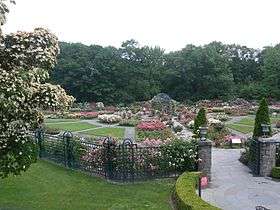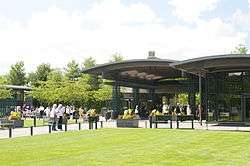New York Botanical Garden
 | |
|
Visitor Center in June 2012. | |
| Established | 1891 |
|---|---|
| Location | Bronx, New York |
| Public transit access |
Botanical Garden |
| Website | |
|
New York Botanical Garden | |
|
| |
| Location |
Southern and Bedford Park Boulevards Bronx, New York 10458 |
| Coordinates | 40°51′49″N 73°52′42″W / 40.86361°N 73.87833°WCoordinates: 40°51′49″N 73°52′42″W / 40.86361°N 73.87833°W |
| Area | 250 acres (100 ha) |
| Built | 1891 |
| Architect | Lord & Burnham Co. |
| Architectural style | Victorian era |
| NRHP Reference # | 67000009 |
| Significant dates | |
| Added to NRHP | May 28, 1967[1] |
| Designated NHL | May 28, 1967 [2] |
The New York Botanical Garden (NYBG) is a botanical garden and National Historic Landmark located in the Bronx, New York City. The 250-acre (100 ha) site's verdant landscape supports over one million living plants in extensive collections. Each year over one million visitors visit the garden's remarkable diversity of tropical, temperate, and desert flora, as well as programming that ranges from exhibitions in the Haupt Conservatory to festivals on Daffodil Hill.
The Garden is also a major educational institution. As of 2016, more than 1,000,000 people annually—among them Bronx families, school children, and teachers—learn about plant science, ecology, and healthful eating through NYBG's hands-on, curriculum-based programming. Nearly 90,000 of those visitors are children from underserved neighboring communities, while more than 3,000 are teachers from New York City's public school system participating in professional development programs that train them to teach science courses at all grade levels.
NYBG operates one of the world's largest plant research and conservation programs, with nearly 200 staff members.
Mission statement
| “ | The New York Botanical Garden is an advocate for the plant kingdom. The Garden pursues its mission through its role as a museum of living plant collections arranged in gardens and landscapes across its National Historic Landmark site; through its comprehensive education programs in horticulture and plant science; and through the wide-ranging research programs of the International Plant Science Center.[3] | ” |
History
The Lorillard family owned most of the land that later became the New York Botanical Garden. That land and adjacent acreage was acquired by the City of New York and set aside for the creation of a zoo and botanical garden. The Garden was established on 28 April 1891[4] on part of the grounds of the Lorillard Estate (formerly owned by the tobacco magnate Pierre Lorillard) and a parcel that was formerly the easternmost portion of the campus of St. John's College (now Fordham University). The Garden's creation followed a fund-raising campaign led by the Torrey Botanical Club and Columbia University botanist Nathaniel Lord Britton and his wife Elizabeth Gertrude Britton who were inspired to emulate the Royal Botanic Gardens in London. It was declared a National Historic Landmark in 1967.[2][5][6]
Grounds

The Garden contains 50 different gardens and plant collections. There is a serene cascade waterfall, as well as wetlands and a 50-acre (20 ha) tract of original, never-logged, old-growth New York forest.
Garden highlights include an 1890s-vintage, wrought-iron framed, "crystal-palace style" greenhouse by Lord & Burnham, now Haupt Conservatory; the Peggy Rockefeller Rose Garden (originally laid out by Beatrix Jones Farrand in 1916); a Japanese rock garden; a 37-acre (15 ha) conifer collection; extensive research facilities including a propagation center, 550,000-volume library, and an herbarium of over seven million botanical specimens dating back more than three centuries.
At the heart of the Garden is the old-growth forest, the largest existing remnant of the original forest which covered all of New York City before the arrival of European settlers in the 17th century. The forest, which was never logged, contains oaks, American beeches, cherry, birch, tulip and white ash trees, some more than two centuries old.
The forest itself is split by the Bronx River, the only fresh water river in New York City, and this stretch of the river includes a riverine canyon and rapids. Along the shores sits the landmark Stone Mill, previously known as the Lorillard Snuff Mill built in 1840. Sculptor Charles Tefft created the Fountain of Life on the grounds in 1905. "It was conceived in the spirit of Italian baroque fountains, with the surging movement of galloping horses and muscular riders."[7]
Research laboratories

The Pfizer Plant Research Laboratory, built with funding from the National Oceanic and Atmospheric Administration, New York State and New York City, and named for its largest private donor, is a major new research institution at the Garden that opened in 2006. The laboratory is a pure research institution, with projects more diverse than research in universities and pharmaceutical companies.
The laboratory's research emphasis is on plant genomics, the study of how genes function in plant development. One question scientists hope to answer is Darwin's "abominable mystery"; when, where, and why flowering plants emerged. The laboratory's research also furthers the discipline of molecular systematics, the study of DNA as evidence that can reveal the evolutionary history and relationships of plant species. Staff scientists also study plant use in immigrant communities in New York City and the genetic mechanisms by which neurotoxins are produced in some plants, work that may be related to nerve disease in humans.
A staff of 200 trains 42 doctoral students at a time, from all over the world. Since the 1890s, scientists from The New York Botanical Garden have mounted about 2,000 exploratory missions worldwide to collect plants in the wild.
At the Pfizer Plant Research Laboratory, genomic DNA from many different species of plants is extracted to create a library of the DNA of the world's plants. This collection is stored in a 768-square-foot (71.3 m2) DNA storage room with 20 freezers housing millions of specimens, including rare, endangered or extinct species. To protect the collection during winter power outages, there is a backup 300-kilowatt electric generator.
The Alfred P. Sloan Foundation has granted the NYBG $572,000 to begin a project called TreeBOL, the Tree Barcode of Life. By sampling the DNA from all 100,000 different species of trees from around the world over the next few years, TreeBOL will document the diversity of plant life, and advance the process of plant DNA barcoding.[8][9]
LuEsther T. Mertz Library

When, in 1881, land was set aside by the New York State Legislature for the creation of "a public botanic garden of the highest class" for the City of New York, the Library and Conservatory were the first two structures built on the grounds. Prominent civic leaders and financiers, including Andrew Carnegie, Cornelius Vanderbilt, and J. P. Morgan, agreed to match the City's commitment to finance the buildings and improvements.
Founded in 1899, the LuEsther T. Mertz Library is the largest, most comprehensive botanical library in the Americas. In addition to botany and horticulture, the Library’s collections are used for studies in fields as diverse as history, anthropology, landscape and building design, architectural history, ethnobotany, economic botany, urban social history, and environmental policy. In addition to current scholarly books and serials, the Mertz Library holds many rare and historically important works ranging from medieval herbals, to 17th-century depictions of the princely gardens of Europe, to accounts of botanical exploration and discovery in the 18th century, to the writings of Carl von Linné (Linnaeus) and Charles Darwin.
The Library has been led by a series of accomplished individuals during its over-100-year history. Their names and dates of service are:
- D.T. MacDougal (acting librarian, 1899)[10]
- Anna Murray Vail (January 1900 – September 1907)[10]
- John Hendley Barnhart (October 1907 – December 1912)[10]
- Sarah Harlow (January 1913 – October 1937)[10]
- Elizabeth C. Hall (November 1937 – 1960)[11]
- James J. Daly, Administrative Librarian (1960–1961)[11]
- Robert Jones, Administrative Librarian, 1962[11]
- Mulford Martin, Acting Senior Curator of the Library (1964–1965)[11]
- John F. Reed, Curator of the Library (1965–1971)[11]
- Charles R. Long, Administrative Librarian (1972–1986)[11]
- John F. Reed, VP for Education and Director of the Library (November 1992 – June 2003)[11]
- Susan Fraser, Director of the Library (2004 – present)[11]
The collection grew both through the purchase of books and through the generous donation of significant botanical and horticultural libraries from notable botanists, gardeners, scientists and book collectors [12] Among the important personal collections to be given to the LuEsther T. Mertz Library are donations from
- Eleanor Cross Marquand
- Sarah Gildersleeve Fife
- Lucien Marcus Underwood
- Robert Hiester Montgomery
- Emil Starkenstein
- John Torrey
- Harriet Barnes Pratt
- David Hosack
Enid A. Haupt Conservatory

The Enid A. Haupt Conservatory is a greenhouse located toward the western end of the NYBG. Inspiration for the park and the conservatory stemmed from Nathaniel Lord Britton and his wife Elizabeth. The couple had visited the Royal Botanic Garden at Kew on their honeymoon and thought a similar park and conservatory should be built for New York City.[13] The conservatory was designed by the major greenhouse company of the late 1890s, Lord and Burnham Co. The design was modeled after the Palm House at the Royal Botanic Garden and Joseph Paxton’s Crystal Palace in Italian Renaissance style.[13] Groundbreaking took place on January 3, 1899 and construction was completed in 1902 at a cost of $177,000.[13] The building was constructed by John R. Sheehan under contract for the New York City Department of Parks and Recreation.[14] Since the original construction, major renovations took place in 1935, 1950, 1978, and 1993.[13]
See also
- Education in New York City
- List of botanical gardens in the United States
- List of museums and cultural institutions in New York City
References
- ↑ National Park Service (2007-01-23). "National Register Information System". National Register of Historic Places. National Park Service.
- 1 2 "The New York Botanical Garden". National Historic Landmark summary listing. National Park Service. 2007-09-17.
- ↑ "Mission and History". New York Botanical Garden. Retrieved 12 April 2012.
- ↑ Jackson, Kenneth T., ed. (1995), The Encyclopedia of New York City, New Haven: Yale University Press, ISBN 0300055366, p. 147
- ↑ ""New York Botanical Garden", January 22, 1976, by Richard Greenwood: National Register of Historic Places Inventory-Nomination" (PDF). National Park Service. 1976-01-22.
- ↑ "New York Botanical Garden--Accompanying 17 photos, from c.1962" (PDF). National Park Service. 1976-01-22.
- ↑ Proske, Beatrice Gilman, Brookgreen Gardens Sculpture, Brookgreen Gardens, SC, 1968 p. 150
- ↑ Botanic Gardens Conservation International notice
- ↑ AP article
- 1 2 3 4 J. New York Botanical Garden, v. 41, # 485, section 2
- 1 2 3 4 5 6 7 8 Librarians of the New York Botanical Garden, compiled by Susan Fraser, Special Collections Librarian, New York Botanical Garden, February 1993
- ↑ Callery, Bernadette G. Collecting Collections: Building the Library of the New York Botanical Garden. Brittonia, 47:44–56, 1995
- 1 2 3 4 Linda Koebner, “Green house,” Landscape Architecture. 87.5 1997, p. 62.
- ↑ Tanner, Ogden. "The New York Botanical Garden", New York. Walker and Company, 1991, p. 90.
External links
| Wikimedia Commons has media related to New York Botanical Garden. |


